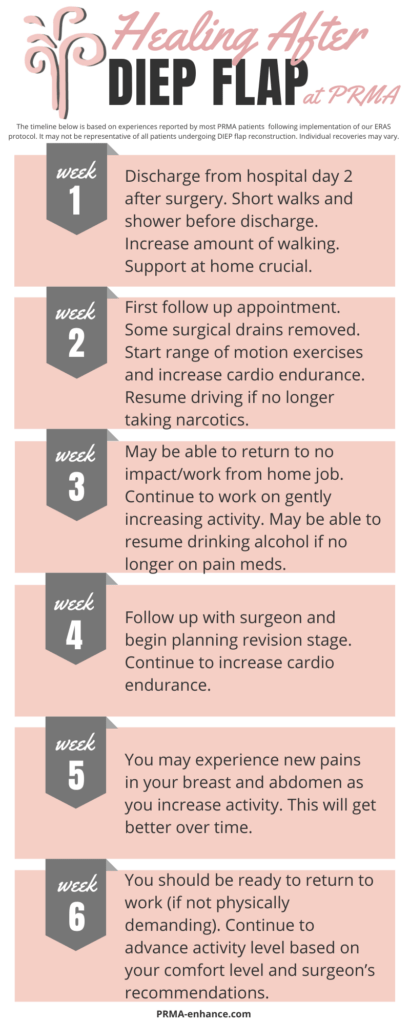What You Need To Know About Prevena
Prevena is a special wound care dressing that is sometimes used to help prevent wound healing problems. Patients who are at higher risk for wound healing problems are those with BMI’s greater than 30, have a history of smoking, or are diabetic. Sometimes, for very thin patients, a Prevena will be used to help with a tight incisional closure. The decision to use Prevena is usually determined during surgery based on the surgeon’s expert judgment.
Help with you PREVENA Incision Management System is always a call away… 800-275-4524.
Learn more about preventative would care following breast reconstruction surgery here.
How Is DIEP Flap Surgery Performed?
The skin and fat below the belly button feels similar to breast tissue. It is a good option to replace the breast tissue removed by the mastectomy.
The blood vessels (“perforators”) keeping this skin and fat alive travel just beneath or within the abdominal muscle. A small incision is made in the abdominal muscle to access them. The tissue is disconnected from the body and transplanted to the chest using microsurgery. The surgeons shapes the tissue to create a new breast.
Some patients anatomy will not allow for full muscle preservation with a standard approach. Usually this is because the tissue needs more than 1 blood vessel to ensure the best blood supply. In some cases, there is intervening muscle between these blood vessels that many surgeons would just cut. Not at PRMA! In these situations, our surgeons perform a modification of the DIEP. This is known as an APEX flap. This technique allows for complete preservation of the patient’s muscle.
Women also enjoy the added benefit of a flatter abdomen with results like a “tummy tuck.” The risk of abdominal complications like bulging and hernia is also very small. Especially when compared with the TRAM.
What Is “Stacked DIEP”?
Sometimes all the lower abdominal tissue is needed to reconstruct one breast. Occasionally this cannot be performed as a single flap. For example, the patient may have a previous mid-line abdominal scar or may be too thin. In these cases, the lower abdominal tissue is transplanted as 2 separate flaps which are then reconnected on the chest to create one breast. This technique is called a stacked DIEP procedure.
A team of two microsurgeons performs every procedure. This ensures patients benefit from the expertise of two specially trained surgeons. Having two surgeons significantly decreases the length of the surgery. This in turn reduces anesthesia time.


What Are The Benefits Of DIEP Flap Surgery?
Most patients are also candidates for sensory nerve reconstruction. Nerves providing sensation to the breast are often cut during a mastectomy. This may cause numbness to the chest and/or reconstructed breast. Sensory nerve reconstruction repairs the nerves that supply feeling to the breast. This procedure improves the return of feeling to the reconstructed breast. PRMA is one of only a few centers in the world to offer this procedure.
Patients who have arm lymphedema from previous breast cancer surgery may also be candidates for Vascularized Lymph Node Transfer. This is performed in combination with DIEP reconstruction. The procedure involves removing healthy lymph nodes from the groin. The healthy lymph nodes are then transplanted to the underarm. This can significantly improve lymphedema symptoms.
Patients who are unhappy with their implant reconstruction results may also be a DIEP flap candidate. Implants can be removed via Explant Surgery. Our surgeons can then reconstruct a breast with a patient’s own tissue. This is something we perform routinely at PRMA. Many patients report being more satisfied with their results after replacing their implants with their own tissue.
What Does DIEP Flap Recovery Look Like?
Knowing what to expect during recovery is important. The healing journey is different for everyone. But, here is an outline of what patients can expect after surgery:
Week One:
Patients stay 2-3 days in the hospital after surgery. Thanks to our ERAS protocol, patients feel well enough to be up walking the morning after surgery. Patients will also take a shower in the hospital. The rest of the first week is spent getting settled back home. Patients will slowly increase walking time and distance. For those traveling from out of state, a follow up appointment in the office is scheduled. This allows travel back home a week or so after surgery.
Week Two:
For local patients, a follow up appointment is scheduled within two weeks after surgery. If drain output is low enough they are removed. During the second week patients will begin easing into their post-operative range of motion arm exercises. By the end of the second week patients can switch from the surgical bra and abdominal binder to a wireless bra and panty girdle. (Be sure to get clearance from your doctor or nurse first.) Most patients also feel comfortable enough to drive. Driving is allowed as long as they are not taking narcotics.
Week Three:
During the third week after surgery, patients typically feel more like themselves. Most at home medications can be resumed if not restarted already. Please clear all medications with your physician first. Any remaining surgical drains are removed. Patients with low-impact/work-from-home jobs can return to work at this time if they desire.
Week Four:
During the fourth week a follow up appointment is scheduled with the surgeon. Planning stage 2 of the reconstruction (the revision stage) starts now. Patients should continue to increase cardio endurance as they feel able.
Week Five:
After the first month, many patient may experience new pains in the breast and abdomen as activity is increased. This is normal and will get better over time.
Week Six:
By week six most patients are released from all restrictions. Most patients are able to return to work as well. Remember, not everyone heals at the same rate. It is important to listen to your body as you resume all activities.
